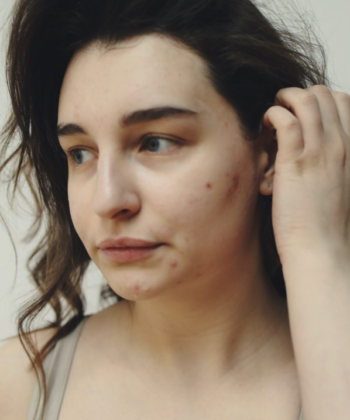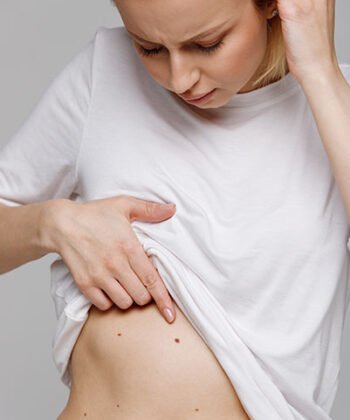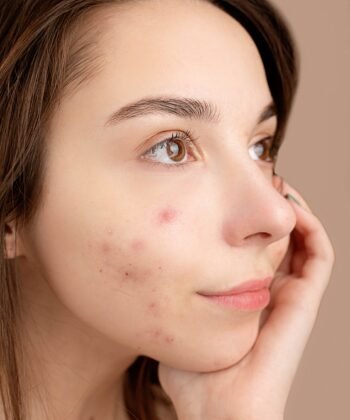The Importance of Checking Your Moles

Moles (naevi) are very common. A melanocytic naevus, or mole, is an area of skin where there is an increased number of pigment cells (melanocytes). There are other types of naevi that have formed from other cell types i.e. not from pigment cells.
Melanocytic naevi are generally brown or black in colour as a result of containing the pigment melanin, so may also be called a pigmented naevus. Some moles are present at birth; however, most moles develop over time, particularly on parts of the body that are frequently exposed to the sun’s ultraviolet radiation. Whilst most moles are benign and completely harmless, moles can develop into Melanoma, a dangerous form of skin cancer. Indeed having large numbers of moles is the highest risk factor for the development of melanoma. It’s important that individuals regularly check their moles for signs of melanoma.
Moles tend to stay the same size, colour and shape, when a mole changes in any way, it is very important to seek consultation from a dermatologist.
When checking and monitoring your moles, it’s not always easy to tell whether or not there is cause for concern. If you have many moles, photography is very helpful in monitoring change as photographs provide a record of the exact appearance of a mole at a certain time point. This can be used for comparison to see if a lesion is changing. Change is one of the most important features to look out for when checking your moles. Most melanoma appear in normal skin, about 25 or 30% of melanoma evolve from a previously benign harmless mole. Some melanoma look like moles initially before it becomes obvious that the pigmented lesion is of concern and needs removing. This similarity between moles and melanoma is one of the main reasons why people need to check their moles.
Picking up a melanoma early is clearly better for the patient as the melanoma is likely to be at an earlier stage and less likely to have spread. If you are not sure about a pigmented lesion, or if it is changing or has become symptomatic then it is best checked by your Dermatologist.
How often should I check my moles?
Everyone with moles should conduct self checks at home regularly. Ideally, it is recommended that moles be checked every month. One of the best ways to stay on top of your moles is to integrate regular checks into a routine. For example, some people find it helpful to check their moles when they get out of the shower or bath.
When to get a mole checked professionally?
There are a number of reasons why someone might need to get their moles checked by a professional. First, if they are at higher risk of developing skin cancer than other people, it’s advisable to get regular professional screenings.
An individual is at greater risk of developing skin cancer if:
- They have fair hair, eyes, or pale skin that burns easily
- They have a lot of freckles
- They have used sun beds
- They have a lot of moles (100+)
- They have large moles (more than 6mm in diameter)
- They or a close relative has previously had a melanoma
- They take medications that compromise the immune system
Another indication that it’s time to schedule a mole check-up is if a mole changes in appearance. New marks, discoloration, changes of shape or outline should be checked by a professional. These are potential signs of a malignant melanoma and will require a mole assessment and possible biopsy. Catching a melanoma early offers the best prospects. In this early stage the melanoma can be surgically removed to prevent further spread.
It’s important to remember that not all moles are found in visible locations – the back, for example. Individuals, particularly those with a lot of moles, may have moles that they cannot see - even in the mirror. These moles are much harder to monitor, and it is advisable for these individuals to schedule a periodic mole screening with a professional.
How to check your moles
One of the best things you can do when checking your own moles at home, is to make it a regular routine. This is mainly because, the better you know your skin, the more likely you are to accurately spot changes. The more regularly you check your moles, the easier it will be to notice those all-important warning signs. Photography can help in
Try to become familiar with the location, colour, patterns, and size of your moles. Then, conduct a head-to-toe check approximately once per month by standing in a well-lit room with a full-length mirror. This will help you check your body all over.
As well as checking the obvious places (arms, legs, face, torso, and back), it’s important to also check those harder to reach areas. This is where the mirror will come in handy. Moles occur everywhere, including between fingers and toes, on the scalp, buttocks, genital area, palms, and the soles of feet.
When observing each mole, try to follow the ABCDE protocol, as follows.
Asymmetry – make sure that both halves of the mole look the same
Border – look out for an uneven or ‘blurred’ border
Colour – has the mole changed colour or is the mole a mix of different shades?
Diameter – is the mole more than 6mm in diameter (bigger than the end of a pencil)?
Evolution – Has a new mole appeared or has an existing mole changed? Has a mole become itchy or bled?
Signs that a mole is dangerous and how to check for melanoma
The ABCDE protocol is designed to help detect possible melanoma. Healthy moles should appear symmetrical in shape, of uniform colour, with smooth edges, and a diameter of 6mm or less. Any mole that lies outside of these parameters should be checked by a Dermatologist who will assess whether or not biopsy is required.
A biopsy involves the surgical removal of a suspicious mole for examination. By conducting a biopsy, the Dermatologist will be able to assess whether or not the pigmented lesion is cancerous and, if so, whether the melanoma has spread to the lymph glands (sentinel node biopsy).
Where to go to get my moles checked?
Moles are best checked professionally by your Dermatologist. Anybody worried about their moles should always get them checked by a doctor. In the NHS your General Practitioner will refer you to a consultant Dermatologist. In the private sector you are able to self refer to a Dermatologist unless you are using a medical insurance company and they require a GP referral.
Some people prefer to have their moles checked at a private clinic. During a mole assessment the Consultant Dermatologist will take a detailed history by asking about the individual’s level of sun exposure and family history of skin cancer. They will then conduct a thorough examination of the patient’s skin and assess each mole using a dermatosocope.
In conclusion
The regular checking of moles on your body is fundamental to maintaining skin health and preventing the spread of melanoma. As well as checking your moles at home once a month, it’s important to reach out to a professional if you notice a suspicious mole or pigmented lesion.
The Dermatology Clinic, London, offers comprehensive mole screenings with top consultant dermatologists. Click here to find out more and book your consultation.

Medically reviewed by Dr. Daniel Glass
UK trained Consultant Dermatologist Dr Daniel Glass is a General Medical Council registered skin specialist, qualified in both adult and paediatric Dermatology.











